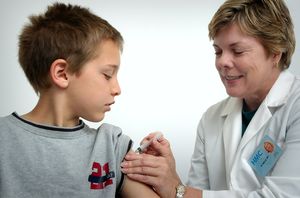Vaccines
This article or area is currently under construction and may only be partially complete. Please come back soon to see the finished work! (6/06/2020)
Original Editor - Lucinda hampton
Top Contributors - Lucinda hampton, Sukhi Dhaliwal, Kim Jackson, Kirenga Bamurange Liliane and Nupur Smit Shah
Introduction[edit | edit source]
Vaccination is one of the most effective ways to prevent diseases. Vaccines protect against more than 25 debilitating or life-threatening diseases, including measles, polio, tetanus, diphtheria, meningitis, influenza, tetanus, typhoid and cervical cancer.[1]
A vaccine is a pharmacologic compound that improves a person's immunity to a particular disease.
- When a disease-causing bacterium or virus invades the human body, the immune system recognizes the material as foreign, usually by detecting specific protein portions of the invading organism, known as antigens.
- Vaccines contain a form of the disease-causing agent, whether it be a weakened or killed form of the microbe itself, an inactivated version of its toxins, or a protein from the surface of the microbe.
- By introducing a form of the agent, the vaccine presents the antigen to the immune system, allowing it to recognize the antigen as foreign and develop antibodies and memory T-lymphocytes against those antigens.
- This allows a more rapid and robust immune response should the body be exposed to the organism in the future.
- In the absence of vaccination, the first exposure to the natural organism may prove fatal before the immune system can mount a sufficient immune response.[2]
Currently, the majority of children receive their vaccines on time. However, nearly 20 million worldwide still miss out – putting them at risk of serious diseases, death, disability and ill health.[1]
Sub Heading 2[edit | edit source]
Sub Heading 3[edit | edit source]
Resources[edit | edit source]
- bulleted list
- x
or
- numbered list
- x
References[edit | edit source]
- ↑ 1.0 1.1 WHO Vaccines Available from:https://www.who.int/topics/vaccines/en/ (last accessed 6.6.2020)
- ↑ Ginglen JG, Doyle MQ. Immunization. InStatPearls [Internet] 2018 Oct 27. StatPearls Publishing. Available from:https://www.ncbi.nlm.nih.gov/books/NBK459331/ (last accessed 6.6.2020)







